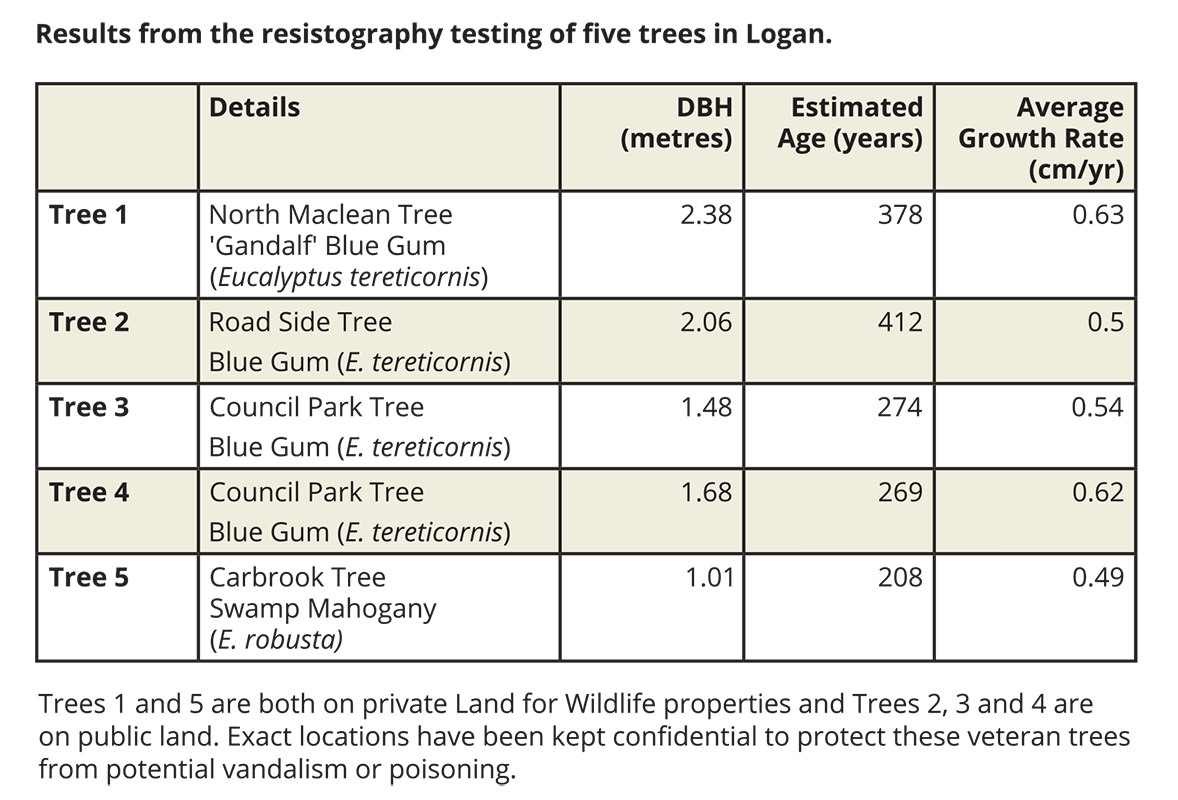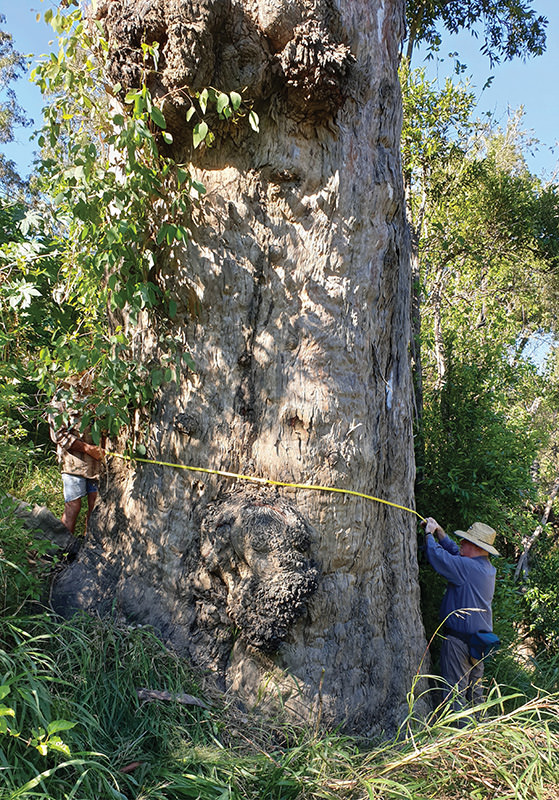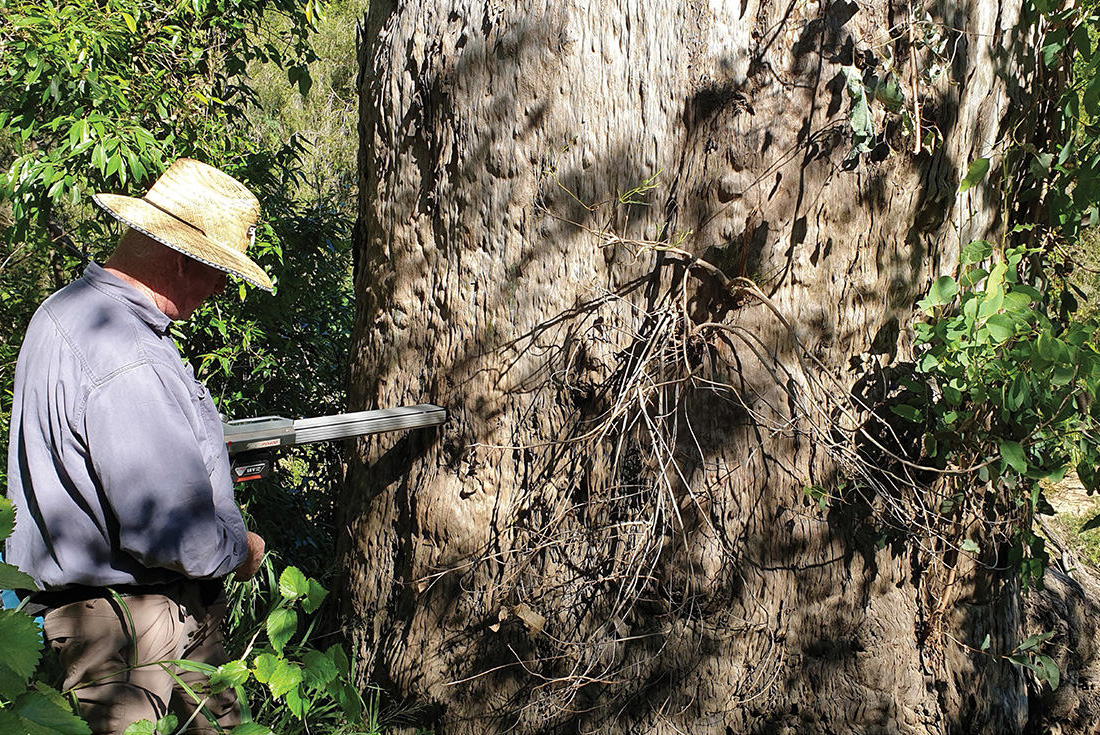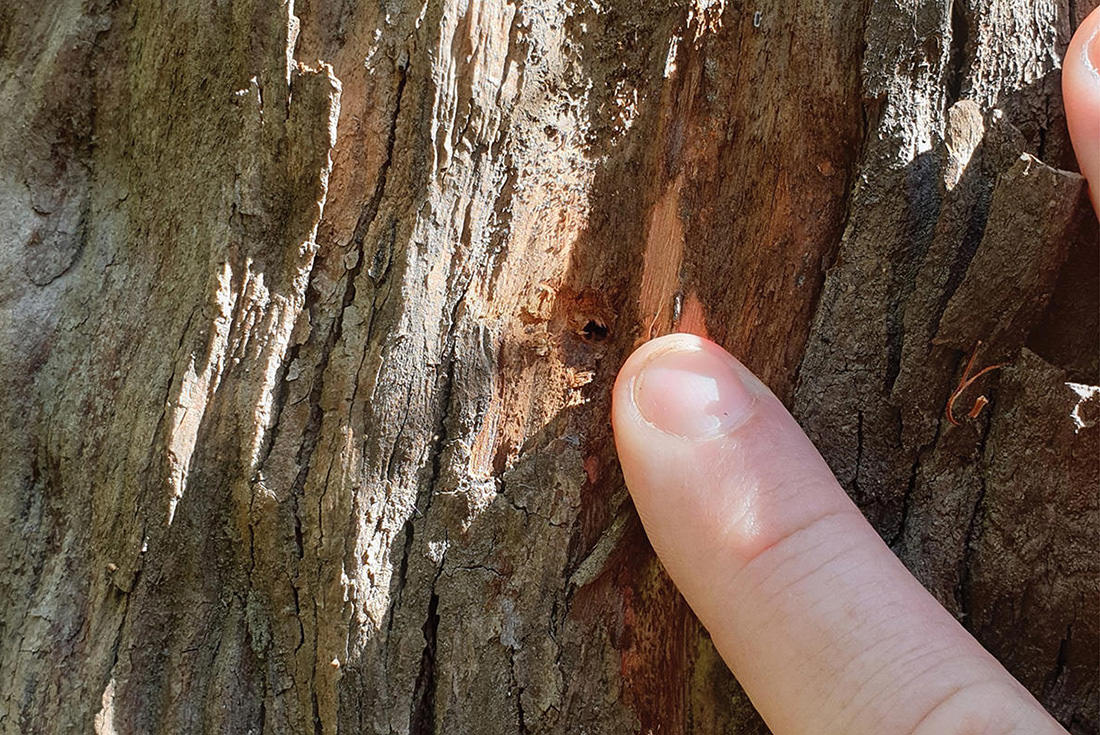Earlier in the year I visited a property in North Maclean as part of a Land for Wildlife assessment. While wandering around with the property owner I spotted a giant Blue Gum (Eucalyptus tereticornis) poking out above the other trees along the Logan River. I was about 100m away but I could still tell that it was a very large tree as the top half of it had snapped off but it was still taller than the other trees around it.

This giant Blue Gum at North Maclean is estimated to be 378 years old. Photo by the Tree Doctor.
Once I was at the base of the tree, I was able to see and appreciate how big it really was. With a diameter at breast height (DBH) of 2.38m it turns out to be the biggest recorded Blue Gum in the Logan region. With the top half snapped off and five large burls climbing the trunk, it certainly had a lot of character indicating, along with its DBH, that it must be old.
As a result of discovering this tree, Logan City Council thought it would be worthwhile to determine its age, along with several other large old trees in Logan. Of the five trees tested four were E. tereticornisand one was a Swamp Mahogany (Eucalyptus robusta).
A method called resistography was used to measure the age of the trees. A resistograph is a machine developed by Frank Rinn from Germany. The resistograph was originally designed for the tree care industry to test for decay and defects that may affect a tree’s health, but it is now widely used to test the structural integrity of timber structures such as power poles and bridge timbers. It does this using a micro drill bit, approximately 3mm in diameter, that enters the wood to a depth of up to 40cm. As it passes through wood with different densities, decay etc., there are changes in the resistance on the drill bit, causing the rotation speed to change. These changes in resistance are recorded by the resistograph and can then be interpreted by analysing the results on a computer.
The resistograph is so sensitive that it can accurately detect the soft and hard wood of the growth rings. By drilling the 40cm into the trunk, on either side of the tree, the arborist is able to obtain a good data set for analysis, allowing him to get an average yearly growth rate. However, as the drill bit is not long enough to reach the centre of the trunk, and growth rings aren’t always yearly, the age is an estimate only but is likely to be within 10% accuracy.
As a result of the tree age testing, it turns out a much less assuming tree (Tree 2) at 2.06m in DBH, and with far less character, is the oldest at 412 years while the tree found at North Maclean (Tree 1) is estimated to be 378 years old.
The two Blue Gums in Council parks also provided some interesting results. Although Tree 4 is 20cm larger in DBH, it is still only estimated to be approximately the same age as Tree 3.

The Swamp Mahogany was found to have a significant amount of decay and so the age estimate of this tree is just a guess. In fact, the arborist suggested that this tree is likely to fail and collapse within two years.
The different rates in growth are likely the result of the different soil types as all the trees are located in areas with similar rainfall patterns and they were all located a similar distance from water so likely had a constant water source. The area where Tree 1 is located, in North Maclean on the Logan River, is very sandy and this would likely explain why its growth rate is the highest of all the Blue Gums tested.

Tree 1 may not be the oldest, but it is without doubt the most impressive of the trees. It was affectionatey given the name ‘Gandalf’ by the arborist based on the wizard fromThe Lord of the Rings, and it was quickly picked up by the media who promoted this as Logan’s largest tree. With its 2.38m trunk, the multiple burls and half the tree missing, it has a commanding presence on the edge of the Logan River. It was agreed by the Land for Wildlife property owner that the name Gandalf was appropriate.
Although the age of these large old trees can be impressive, the focus should be on the significant environmental value they provide. Trees of this age often have many hollows providing breeding and roosting sites for all kinds of native fauna. They also help stabilise soil from erosion and create a mini micro-climate that may increase soil moisture and support beneficial fungi. They also provide habitat in the form of food or shelter for a host of small reptiles, birds and invertebrates.
Many of these veteran trees in our landscapes are important cultural icons for Indigenous people and give all Australians an insight into historic land management. Many veteran trees are artefacts of Indigenous land use, especially the use of regular cool fires, which would have prevailed when these old Logan trees germinated.
Logan City Council hopes that by continuing to carry out age testing on other trees, it will help the community see the environmental and cultural importance of these large old trees and the significant amount of habitat they provide our native fauna. It’s also a way for Council to showcase what an old tree looks like as, unfortunately, most trees people see are relatively young and some people are not aware that veteran trees like Gandalf were once common throughout the landscape.
Logan City Council plans to continue age testing and will create a register of the large old trees throughout the Logan area, with a layer to be created on its mapping system. As such, if you live in Logan and have a large old tree in your own backyard, we’d love to know about it. Please email [email protected] with a photo.
Nick Swanson
Conservation Partnerships Officer
Logan City Council



Hello Mike Johnson here from Bundaberg Landcare we would love to get some of the dry rainforest trees tested up this way is there any chance up discussing this with those conducting the resistor graph
Hope you can assist regards Mike Johnson president
Hi Mike. The company that did the resistograph testing for Logan City Council was The Tree Doctor https://www.thetreedoc.com/services. Hope they can help you. Cheers.
Hello,
I had understood that ‘tereticornis’ is a Redgum not a Bluegum.
Cheers.
Forest Red Gum and Blue Gum are used interchangeably for Eucalyptus tereticornis. Depends on whether you come from a forestry perspective (red timber) or ecosystem perspective (blueish trunk).